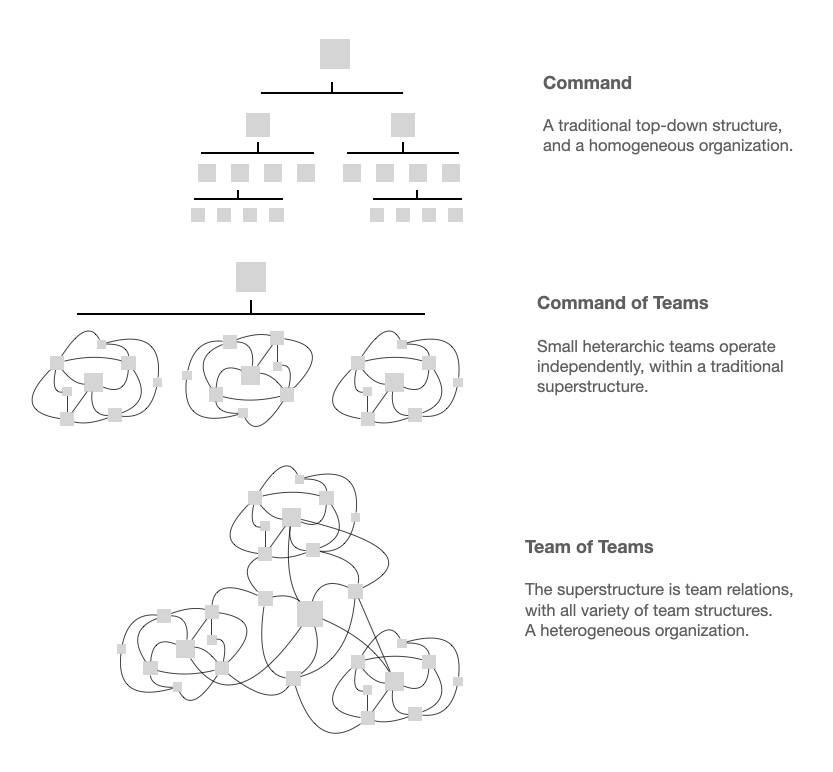The Ecology of Work: Growing Resilient, Growing Wilder
The need for self-willed organizations.
You can’t endorse a top-down authority structure and be serious about enhancing adaptability, innovation, or engagement.
| Gary Hamel, Bureaucracy Must Die
Today’s CEOs are reacting to current economic, political, and health challenges by mandating a transition to greater resilience across their operations, but whether they grasp the complexities of growing more resilient is uncertain.
Gary Hamel and Liisa Välikangas make a clear distinction between a deep and abiding capacity of resilience versus simply responding to disruptive events:
Strategic resilience is not about responding to a one-time crisis or rebounding from a setback. It’s about continually anticipating and adjusting to deep, secular trends that can permanently impair the earning power of a core business. It’s about having the capacity to change even before the case for change becomes obvious. To thrive in turbulent times, companies must become as efficient at renewal as they are at producing today’s products and services.
To achieve strategic resilience, companies will have to overcome the cognitive challenge of eliminating denial, nostalgia, and arrogance; the strategic challenge of learning how to create a wealth of small tactical experiments; the political challenge of reallocating financial and human resources to where they can earn the best returns; and the ideological challenge of learning that strategic renewal is as important as optimization.
The authors have framed resilience as more than the ability to respond to adversity or disruption. Instead, Hamel and Välikangas introduce the idea of ‘strategic renewal’, which they frame as being in key ways a clear alternative to optimization. Consider that optimization of business operations is driven by today’s understanding of the future, and the premise of stability over some timeframe, such as the next five years. In a time of uncertainty, regular reappraisal of the marketplace and customer needs may require rapid shifts in operations, invalidating the time and effort invested in optimization.
Ethan Bernstein also zooms in on the tension between adaptability and reliability:
All organizations must achieve both reliability and adaptability to some degree, but usually one eclipses the other. Too much standardization for the sake of reliability can make businesses insensitive to changing markets. Too much emphasis on adapting can cause them to fragment and lose the leverage that comes with focus and scale (recall how Apple cast about during Steve Jobs’s hiatus). Although managerial hierarchies can err in either direction, they most often skew in favor of reliability—and create rigidity and red tape.
Business organizations are often idealized through the lens of business processes, the linear sequence of steps that process insurance claims, track sales campaigns, or coordinate production across supply chains. But business organizations are in fact underpinned by complex social networks, where individuals and groups are connected to others, and their relationships are not linear, but better considered as circles of communication, through various degrees of connection. In fact, as we shall see, we may need to step outside the conventional management discourse about organizations, and view them instead ecologically, if we want to achieve higher levels of resilience.
The Spectrum of Organizational Formations
The conventional form of organization is a hierarchy, where decision-making is sequestered in the upper tier of tightly-managed management ranks, and bureaucratic systems of control are the norm.
At the other end of the dimension of organizational forms is the heterarchy, here described by Satoshi Miura:
Heterarchy [is a] form of management or rule in which any unit can govern or be governed by others, depending on circumstances, and, hence, no one unit dominates the rest. Authority within a heterarchy is distributed. A heterarchy possesses a flexible structure made up of interdependent units, and the relationships between those units are characterized by multiple intricate linkages that create circular paths rather than hierarchical ones. Heterarchies are best described as networks of actors—each of which may be made up of one or more hierarchies—that are variously ranked according to different metrics. Etymologically speaking, the term is made up of the Greek words heteros, meaning “the other,” and archein, meaning “to rule.”
[...]
At their core, heterarchical networks are considered both flexible and dynamic; authorities therein are not institutionally fixed but rather change places as situations evolve. Swedish politician Gunnar Hedlund remarked in 1986 that nested hierarchies and even markets could be observed in some multinational corporations. In such organizations, heterarchy could be conceived as a metagovernance mechanism of flexible coordination among transactions organized by different actors. In The Sense of Dissonance: Accounts of Worth in Economic Life (2009), American sociologist David Stark observed that a heterarchy’s linkages between one unit and another—usually across such conventional divides as levels, departments, and sectors—form a multicentric network of heterogeneous actors with distinctive resources and capabilities. That structure, he argued, makes an organization more productive and gives it the ability to adapt to rapid changes.
Figure 1 shows a spectrum of organizational forms, running from a command-and-control, top-down hierarchy through two heterarchic forms: ‘command of teams’ and ‘team of teams’ heterarchies. Note that this shows that heterarchy can include hierarchies.
The difference lies between thinking about a business as a set of linear processes to be optimized for speed and cost versus considering a business as an ecology -- a circular network of interdependent competing and cooperating organisms -- from which the capacity for resilience may emerge when the conditions are right.
When we examine them, the most resilient ecosystems in nature can be characterized as heterarchical: no one species is ‘in charge’ of the ecology. It is not optimized to some defined end state, but instead, the participants make their own decisions, create their own alliances and competitions, and the result is -- in the absence of catastrophic disruption, such as humans clear-cutting forests -- a natural ability to respond to stress.
Resilient ecosystems, when considered from network theory, are based on many weak ties linking the participants, as opposed to a fewer number of strong ties in non-resilient ecosystems.
Consider resilience in high-stress teams:
Evidence from personality profiles and from studies of military, corporate and space flight crews suggests that looser ties between group members can be a strength, if the team includes individuals who can generate collective emotion when needed.
“So much of psychology and sociology emphasizes the importance of communicating and creating strong bonds to improve group performance, but in a lot of situations that is just not how it works,” said Dr. Calvin Morrill, a professor of sociology at the University of California, Irvine, who has studied group behavior in competitive corporate situations and in high schools. “Baseball is an odd mix of an individual and team sport, and an ideal example of where a diffuse team with weak ties to one another may help the overall functionality of the group.”
[...]
In studies of neighborhood organizations and corporate teams, social scientists have observed that members with weak ties can withdraw from disagreements without disrupting the group or their own work.
On a tightly knit team, by contrast, a falling out between key members can divide a squad, forcing people to take sides, psychologists say. “The idea is that any sort of problem is likely to ripple more strongly and quickly through a close group than one with weak ties,” said Dr. Mark Granovetter, a professor of sociology at Stanford.
Growing Wilder To Become More Resilient
Perhaps corporate leaders need to reconsider the ‘business as a machine’ mindset that places optimization of business processes above the agility and flexibility that underlies resilience. Instead of seeking to make the company into the leanest possible linear system -- a strategy of reduction -- leaders could instead aspire to looser, wider connections across the company, and an intentional diminishing of downward control. These are the hallmarks of deep resilience.
This is a model, again, we can adopt from natural ecosystems: more weak ties, more incidental interactions, more resilience.
Keep reading with a 7-day free trial
Subscribe to workfutures.io to keep reading this post and get 7 days of free access to the full post archives.


